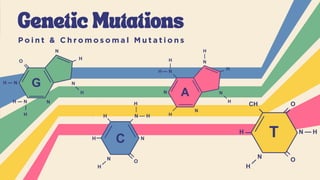The document outlines a comprehensive lesson plan on chromosomal mutations, focusing on how genetic disorders manifest and their impact on individuals and families. Students will engage in group activities analyzing various genetic disorders, exploring gene mutations, and discussing the implications of whole genome sequencing. Additionally, they will learn about mutations' effects on protein structure and function, providing insights into genetic diversity and inheritance.












































